




Advanced Search
Dress Up | 1st Person | African American Map | Now Read This | Magic Lens | Tool Videos | Architecture | e-Postcards | Chronologies
David Cohen - 1917-1941: David Cohen's early lifehis youth, the Great Depression and his educationBorn and raised in New York City, David Cohen's first job took him to the coal mining region of West Virginia. As a young man, David was a keen observer of many facets of American society. His story offers us a glimpse of life in the United States before World War II... Learn more about David Cohen: View a timeline of his life and listen to his full interview. Stories by this speaker
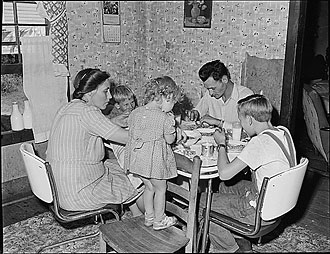
Richard Hughes was a miner for the Panther Red Ash Coal Corporation in McDowell County, West Virginia. In 1946, eight years after David Cohen lived in the coal mining district, Russell Lee photographed the miners. Lee's caption states, "Richard Hughes, miner, and his family eating. This family lives in a four room house for which they pay $9 monthly. Charges for electricity, paid directly to power company, are about $2.50 monthly." As a young Jewish man living in 1930s America, David Cohen faced a certain amount of discrimination. He remembers having been called, more than once, a "Christ killer," and relates that his Jewish neighbors' windows were frequently broken by groups of people who promoted anti-Semitism. David considers his first "taste of discrimination" to be when, as a new high school graduate in 1938, he tried to find a job. He remembers, "I went to an agency down around the Wall Street area, and I was with a, an Italian who was Catholic. And everybody was sent out for jobs but the Catholic and the Jewish boy." David ended up working as a furniture salesman in the mining district of Princeton, West Virginia. He remembers that the coal miners were "the nicest people," and that before labor organizer John L. Lewis helped them to gain a better rate of pay, they had been "really taken advantage of." David learned, for instance, that the miners were required to "load two tons of coal…to get paid for one, because the operators told them that there was slag, there was dirt in there." As coal miners lived in small houses owned by the mining company, a large portion of their wages was returned to their employer in the form of rent, and in money spent purchasing supplies at the company store. Russell Lee, from the series Photographs of the Medical Survey of the Bituminous Coal Industry, compiled 1946-1947, National Archives, NAIL Control Number: NWDNS-245-MS-1922L. 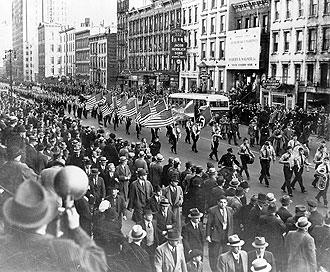
A Nazi party flag leads a procession of American flags at a German American Bund parade which took place in New York City in October 1939. The Nazi party had a place on the fringes of American society in the late 1930s. There were, at this time, a number of groups of Americans who took anti-Semitic and pro-Nazi stances. In 1939, reporter Alvin Johnson claimed, "There are about 800 organizations in the United States carrying on a definite anti-Semitic propaganda. Some are nation-wide in their operations, some regional; but most of them are one man shows."1 The German American Bund, for instance, had about 25,000 members. A rally of the German American Bund in February 1939 coincided with George Washington's birthday. The program was called "Free America!", and the event drew about 20,000 participants. It featured speeches filled with praises for the Nazi party in Germany and anti-Semitic warnings which suggested that Jewish Americans held disproportionate economic and political power in the United States. Most Americans found the German American Bund frightening. On the other hand, discrimination against Jewish people reached its peak in the United States during the 1930s. David Cohen refers to Father Coughlin, who broadcast "a radio program…[called] 'Social Justice'... . And he was very aggressive at first, you know, social justice. Little by little, it came out how anti-Semitic he was." Millions of Americans listened to Coughlin's radio show during the 1930s.2 In contrast, David Cohen joined the YPSL's, the Young People's Socialist League, which was aligned with the Communist Party of America by the second decade of the twentieth century. Father Coughlin, the members of the German American Bund and members of the Young Peoples' Socialist League all had something in common, however. They all shared and exercised the right to free speech and the right to peacefully assemble in groups, rights granted and protected by the United States Constitution. World-Telegram photo, German American Bund Parade in NYC on East 86th St. Oct. 30, 1939, Library of Congress, Prints and Photographs Division, cph3c17148, released into the public domain by the New York World-Telegram and the Sun. 1 Alvin Johnson, "The rising Tide of Anti-Semitism," Survey Graphic, Vol. 28, No. 2. February 1939, p. 113, http://newdeal.feri.org/texts/328.htm retrieved May 13, 2009. 2 Holocaust Encyclopedia, "Charles E. Coughlin," United State Holocaust Memorial Museum Website, www.ushmm.org retrieved May 13, 2009. 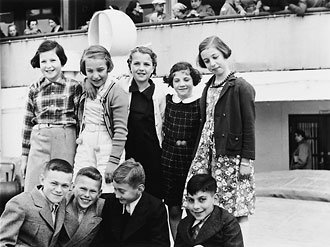
A group of nine Jewish refugee children traveling on the SS St. Louis in May 1939 are gathered for a group picture. The situation of the Jewish people living in Germany grew increasingly precarious through the 1930s. The Law for the Restoration of the Professional Civil Service, enacted in 1933, ensured that German Jews could no longer hold German government positions or work as professors, judges, or teachers. The Nuremberg Laws, passed in 1935, introduced still more restrictions and revoked citizenship for German Jews. Under “The Law for the Protection of German Blood and German Honor," Jewish people and German citizens could not marry, and Jewish people were not allowed to display the German national flag. In early November 1938, following the killing of a German embassy official by a seventeen-year-old Polish Jew whose family, along with 12,000 other Polish Jews, were being expelled from Germany, the Nazi party took revenge on the whole of the Jewish population. They arrested young men, shattered thousands of Jewish storefronts, and destroyed Jewish synagogues. Many Jewish people began trying to leave Germany after this Kristallnacht, "the Night of the Broken Glass." In May 1939, the SS St. Louis, carrying over 900 Jewish refugees tried to gain entrance to Cuba. Upon arrival, they discovered that their Cuban landing certificates were no longer valid. The State Department of the United States also denied them refuge, and they were forced to seek asylum in Europe. The United States had carefully restricted immigration since the passage of the Immigration Act of 1924, and continued to do so throughout most of World War II. While most of the refugees aboard the SS St. Louis eventually found asylum and survived the war, many of them were killed by the Nazis. For instance, Herbert Karliner and Walter Karliner, the two brothers in the lower left corner of the above portrait were the only members of their family who survived. Group portrait of Jewish refugee children on board the St. Louis. United States Holocaust Memorial Museum, Photo #61127. Note: The views or opinions expressed in this exhibit Web feature and the context in which the images are used, do not necessarily reflect the views or policy of, nor imply approval or endorsement by, the United States Holocaust Memorial Museum. 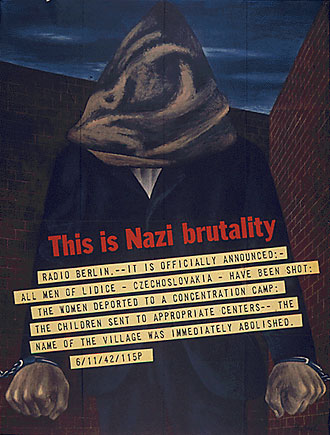
Ben Shahn's "This is Nazi brutality" poster, created in 1942 for the Office of War Information, proclaims the genocide that occurred in the village of Lidice, Czechoslovakia, in June 1942. By the time the United States entered World War II, at the end of 1941, over a half million Jewish people had been put to death. What did Americans know about the Holocaust while it was occurring, and how soon did they know it? It wasn't until August, 1942, that the overwhelming extent of Nazi Germany's plan to exterminate the whole of the European Jewish population came to the attention of the United States Government. Rabbi Stephen S. Wise of the Jewish American Congress also received this information, and was asked not to make it public until it had been confirmed. In November, Rabbi Wise was allowed to release his report. The media did not highlight the story, and those Americans who learned about Rabbi Wise's shocking report in the New York Times found it on page ten. The Times article began, "Dr. Stephen S. Wise, chairman of the World Jewish Congress, said tonight that he had learned through sources confirmed by the State Department that about half the estimated 4,000,000 Jews in Nazi-occupied Europe had been slain in an 'extermination campaign.'"3 American attempts to rescue the Jewish people were made primarily by Jewish organizations, until January 1944 when President Roosevelt signed Executive Order 9417 that created the War Refugee Board, saving about 20,000 Jewish people. The United States Army reached and began liberating Nazi concentration camps in the spring of 1945. Ben Shahn, "This is Nazi Brutality," 1942, Office of War Information, National Archives, NAIL Control Number: NWDNS-44-PA-245. 3New York Times, "Wise gets Confirmation; Checks with State Department on Nazis' 'Extermination Campaign,' November 25, 1942, page 10. nytimes.com retrieved 6/9/08. 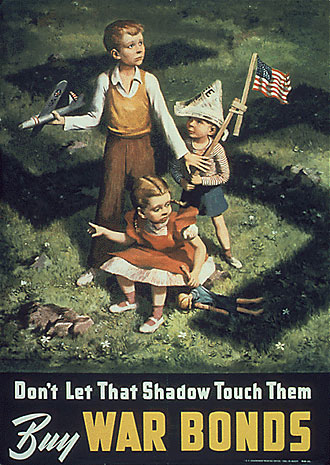
Americans were encouraged often to "Buy War Bonds." In this case, the purchase would protect American children from the shadow of Nazi Germany. During a campaign speech delivered in August 1936, President Franklin Roosevelt appealed to the majority of American voters who did not want again to be drawn into the world's military conflicts: We are not isolationists except insofar as we seek to isolate ourselves completely from war. Yet we must remember that so long as war exists on earth there will be some danger that even the nation which most ardently desires peace may be drawn into war. I have seen war. I have seen war on land and sea. I have seen blood running from the wounded. I have seen men coughing out their gassed lungs. I have seen the dead in the mud. I have seen cities destroyed. I have seen 200 limping, exhausted come out of the line--survivors of a regiment of 1,000 that went forward 48 hours before. I have seen children starving. I have seen the agony of mothers and wives. I hate war.4 The United States was reluctant to enter World War II, and did so only after the Japanese executed a sneak attack on the United States Naval Base at Pearl Harbor, Hawaii on December 7, 1941. While we now know that the mainland of the United States was not attacked during the war, Americans living through the war could not have predicted what dangers the country might face. Office of War Information posters suggest that, throughout the war, the primary goal of the country was to ensure the nation's security. Civilians and soldiers alike banded together to create war fronts at home and abroad which would stop the threat of Fascism and ultimately, protect the United States and its people. Lawrence B. Smith, "Don't Let That Shadow Touch Them, Buy War Bonds," 1942, National Archives, NAIL Control Number: NWDNS-44-PA-124. 4Franklin D. Roosevelt, "I hate War" speech presented at Chautauqua, New York, August 1936. www.sagehistory.net/worldwar2/docs/FDRChautauqua.html , retrieved June 17, 2009. Story Clip #1:David Cohen is born and raised in Brooklyn, New York Wait for each file to download, then click the arrow to play the audio. It starts back in Brooklyn, New York. I was born December 11th, 1917, in a tenement in Brooklyn, New York, the Brownsville section of Brooklyn, which was the Jewish section. If you didn't live in the East Side in Jewish, you lived in Brownsville. And I was...lived there until I was three, four years old. Then we moved to a section, Bushwick section in Brooklyn. It was a mixed neighborhood. In fact, it was predominately German. It became the second largest German area after Yorkville, New York. And I had a...uneventful beginning, you know. My parents were nice. I had three older sisters, and I was the spoiled brat. I was the first male born into the...into our family, and when I was born, it was like little Jesus was born, my sisters said. You know, they all catered to me. I was the sp...you know...my father gave me everything. I wanted...I became interested in baseball. Baseball was my life for...for quite a while. I was educated in Brooklyn...went through elementary school and I was held back the first year. That was a traumatic experience in life. I was sick. I had the measles, mumps, chicken pox, and a swollen gland, all at one time, and I missed three-quarters of the term. We didn't have...go by the year. We went by a term in those days. It was 1A, 1B, and I was left back. I was held over in the...1A. And I don't think I felt so bad about being held over, but Mrs. Rex, the teacher, gave everybody a...a coloring book, but I was left back and she didn't give me the coloring book. I look back...I think, she had'a be mea...she was so nice, but she was mean. Why didn't she give me a coloring book? But anyway, I went through elementary school. I skipped three times and then I was sent to uh...special progress junior high school. Story Clip #2:David's education at a New Deal high school in Queens, New York and in West Virginia And I went to a brand new high school that was built by the WPA. I remember the Roosevelt administration...in Queens...Grover Cleveland High School, and I had three years there, naturally. And then I went to West Virginia. I was only sixteen years old. My mother didn't want to send her nice little Jewish boy, you know, out of town. But my sisters insisted. In order for me to grow up, I'd have to go out. So I went to West Virginia. My first year I went to a...a Baptist school in southern West Virginia. And then from there I went to the University of West Virginia. I graduated...did pretty well. I majored...my mother wanted me to be a dentist. But I couldn't stand the sight of blood. I, I liked history, so I majored in history and minored in economics. Story Clip #3:The Great Depression and David's good friend Maddy Fisher Q: Before we move on, I just want to ask you if you remember, specifically, things during the Great Depression, Oh...that moved me quite a bit. I remember I, when I tell'em I joined the Young Socialists, the YPSLs, they were called, the Young Socialist People's League [Mr. Cohen is referring to the Young People's Socialist League.] because what I saw...I remember, I slept in my...front porch, we called it, and at night, I could hear men going...digging through our garbage pail for food. And, I remember the long lines at the apple being sold on the corner... Q: Did it affect your family, directly? Not my...my father was a carpenter and a glazier and a locksmith, mostly a glazier. And he was a hard working man. He worked, and he had a store, and he was an honest guy, so everybody in the neighborhood...they were all non-Jews, mostly, you know...we weren't discriminated in the immediate area. But, uh, I was called a "Christ killer" more than once in my lifetime. I remember I had a, an Irish friend, a good Irish friend. He w...His mother was Irish Catholic and he went to parochial school. And one day the nun said, Christ...the Jews killed Christ. And Maddy Fisher walked out of the room and never went back. Q: That was your friend? Yeah. Q: How old was your friend, or how old were you? He was a year older than I was. He must've been...it was around like the seventh grade, so he might have been about twelve, thirteen. And Maddy taught me how to box. He was the Irish...you know, the little Jewish boy didn't know anything, but he...he told me how to defend myself, and uh, unfortunately, I received the last letter from him in Italy. He was a lieutenant in the 34th Infantry Division. And after...he wrote a letter saying that, uh, he just got out of the hospital and...he couldn't stand it anymore in the hospital, and he went back to his outfit and he was killed. I got the last letter he wrote. So it was kinda sad. His father was in the Sinn Fein movement in Ireland. I remember him telling me the story...the British, they would catch the Irish and throw'em out of a window, actually throw'em out of a window. They weren't...people aren't very nice, you know? Story Clip #4:Father Coughlin, Social Justice and "It Can't Happen Here", or can it? Well, where I lived in this Ridgewood area in Brooklyn, where I lived, it was on the border of Queens. They had a Nazi party there, a Nazi group. They used to walk around and, and uh, in brown shirts with swastikas, you know, and they'd get...and there was a social democratic club, old Germans. And my father's friends, they were... Q That was back in the 30s? Yeah, well, 30s, early 40s. They uh, they broke their window all the time. They were throwing'em in the streets, you know, people don't realize. But we...Nazis...It was a...might say a Fascist group in this country. You've heard of Father Coughlin. There was uh, the American First group [America First Committee]...they were really, you know, uh, a Fascist...they were what we call Nazis today, in those days. Fr. Coughlin...did you ever hear of him? He had a radio program. "Social Justice", he called it, with the newspaper. And he was very aggressive at first, you know, social justice. Little by little, it came out how anti-Semitic he was. In fact, the pope, the papacy shut him up. He was...I don't know if he was defrocked, but he was sent to Siberia somewhere in America. But uh, it was an active group. It was...a lot of anti-Semitism and uh, the country was on the brink. It could have gone Fa...people don't realize it, but it's a good thing someone like Roosevelt came along, and then...balance. But there was a lot of Fascism. In fact, there was a book by Sinclair Lewis, It Can't Happen Here. You might want to get a hold of it and read it. How, you know, what happened with the...a Fascist Nazi group took over. I think the name was Winthrop. I don't know how I remember. Story Clip #5:West Virginia Coal Miners and John L. Lewis I graduated in '38 and then I knocked around. And then I had my first experiences of really being Jewish. I tried to get a job, and I went to an agency down around the Wall Street area, and I was with a, an Italian who was Catholic. And everybody was sent out for jobs but the Catholic and the Jewish boy. It was our first, you know, taste of discrimination. But anyway, I knocked around. I took little jobs here and there. And, uh, one day I got a letter from a friend in West Virginia, Come down to...you're not working...come down to Princeton, West Virginia, near Bluefield. That's on the Virginia border. And I worked in a furniture store. I never had any experience but, he said, you'll learn. And I did. And I worked in a furniture store in the coal mining district. Q: Were you selling furniture? I sold furniture. And I wanna tell you, the nicest people were the coal miners...and they were really taken advantage of. I remember John L. Lewis was there, their guard. 'Cause I remember stories they told me. They would have to dig two tons of...load two tons of coal...coal to get paid for one, because the operators told them that there was slag, there was dirt in there, and that uh...didn't make any sense to the operators, so they had to dig two tons to get paid for one. And after John L. Lewis organized'em, they made six dollars an hour, which was pretty good money in those days. And...it was really...I enjoyed, you know, my stay down in West Virginia. Related ResourcesThe following source file was not found: ebdav/centuries/html/resource/cohen1917.html
|
| |
Home | Online
Collection | Things To Do | Turns
Exhibit | Classroom | Chronologies | My
Collection
About This Site | Site
Index | Site Search | Feedback